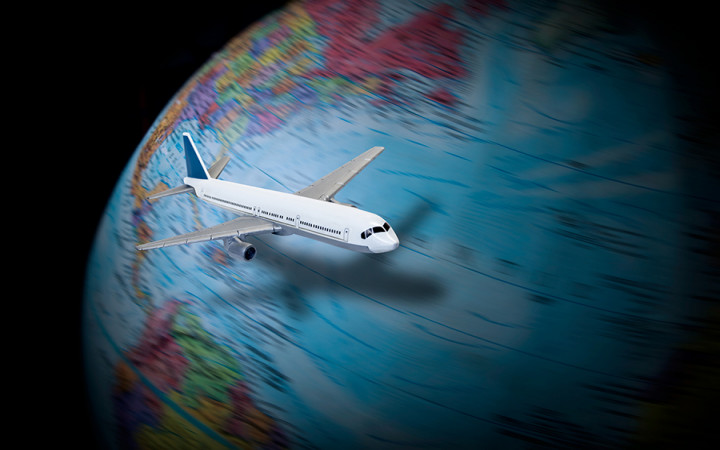Have you ever looked at a flight path on a map and wondered why airplanes take curved routes instead of flying in a straight line? Wouldn’t flying in a direct line be more fuel-efficient and faster? At first glance, it seems logical that a shorter distance would result in less fuel consumption, but in reality, aviation is far more complex.
Several factors determine flight paths, including the Earth’s shape, jet streams, weather conditions, and air traffic regulations. Let’s break down why airplanes rarely fly in a straight line and how their curved paths actually make flights more efficient.
The Earth’s Shape and the Great Circle Route

One of the biggest reasons airplanes don’t fly in a straight line is the Earth’s curvature. While we often view flight maps as flat, the Earth is a sphere, and the shortest path between two points is actually an arc called the Great Circle Route.
If you take a globe and use a string to connect two distant locations, you’ll notice that the shortest route often curves rather than follows a straight path. This is why flights from New York to Tokyo pass over the Arctic region rather than flying directly west across the Pacific Ocean.
Using the Great Circle Route helps planes save both time and fuel, even though it appears curved on a flat map.
Jet Streams and Weather Conditions Impact Flight Paths
Another key factor affecting airplane routes is jet streams—high-altitude wind currents that move at speeds of up to 200 mph (320 km/h). Pilots strategically plan routes to take advantage of these strong winds when possible.
Video : Why Airplanes Don’t Fly Straight
Flying with jet streams allows an airplane to get an extra push, helping it move faster while burning less fuel. Flying against a jet stream can slow down the plane significantly, increasing fuel consumption. Pilots often adjust routes to avoid strong headwinds, even if it means flying a longer distance.
Additionally, storms, turbulence, and severe weather conditions also play a role in determining flight paths. Airplanes may adjust mid-flight to bypass dangerous weather zones, thunderstorms, or areas with extreme turbulence.
Air Traffic Control and Flight Regulations
Air traffic isn’t a free-for-all where planes can just fly wherever they want. There are strict regulations set by aviation authorities and air traffic control (ATC) that dictate flight routes.
Some of these rules include restricted airspace, where certain areas, such as military zones, national security locations, and political zones, prohibit commercial flights from entering. Predefined flight corridors exist to avoid mid-air collisions, ensuring flights follow established air traffic lanes. Major airports handle hundreds of flights daily, so ATC ensures safe and efficient arrivals and departures.
Due to these regulations, airplanes cannot always take the most direct path and must follow designated routes instead.
Avoiding Air Turbulence for Passenger Comfort
Turbulence can make a flight uncomfortable, and pilots actively adjust routes to minimize rough air conditions. There are different types of turbulence, including thermal turbulence caused by warm air rising from the ground. Flying at higher altitudes helps avoid this.

Mechanical turbulence happens near mountains and rough terrains where wind patterns shift unpredictably. Clear-Air Turbulence (CAT) is sudden, strong air currents in high altitudes that are difficult to predict.
To ensure a smoother ride for passengers, pilots may deviate from the shortest path to avoid these turbulent areas.
Why Do Airplanes Sometimes Ascend Before Landing?
If you’ve ever been on a flight where the plane suddenly climbs just before landing, you might have felt a bit concerned. This maneuver is known as a go-around and is actually a common and safe aviation practice.
Some reasons why pilots perform a go-around include runway clearance issues. If another plane hasn’t cleared the runway in time, pilots must abort the landing and circle back. Poor weather conditions, such as poor visibility, strong crosswinds, or sudden gusts, can make a landing unsafe. If a plane is too fast, too high, or not properly aligned with the runway, the pilot will ascend and try again for a safer landing.
Go-arounds are standard procedures in aviation and ensure passenger safety above all else.
The World’s Longest Non-Stop Flight
While most flights follow curved paths, some routes push the limits of non-stop travel. The longest direct commercial flight in the world is from Singapore to Newark, New Jersey, USA.
This flight covers a distance of 10,400 miles (16,700 km) and takes approximately 18 hours and 45 minutes. It follows a carefully optimized path to balance fuel efficiency, wind conditions, and passenger comfort.
Video : Does Earth’s Rotation affect the Airplanes Speed & Flight Time
What Happens If a Plane Suddenly Loses Cabin Pressure?
A sudden drop in cabin pressure is often portrayed as a dramatic event in movies, but in reality, pilots are well-trained to handle it calmly.
When this happens, oxygen masks automatically deploy, and passengers should put them on immediately and breathe normally. The plane will descend to a safe altitude where oxygen levels are sufficient for breathing. The flight crew will assess the situation and communicate with passengers.
Losing cabin pressure doesn’t mean the plane will crash—pilots follow strict safety protocols to handle such incidents efficiently.
Final Thoughts: Why Curved Flight Paths Are More Efficient
While it may seem counterintuitive, airplanes take curved routes instead of straight lines to optimize flight efficiency, fuel usage, and passenger safety. Factors such as the Earth’s shape, jet streams, air traffic control, and weather conditions all play a crucial role in determining flight paths.
So next time you’re on a plane and see the route map displaying a curved flight path, remember there’s a lot of science and planning behind it to ensure you reach your destination as safely and efficiently as possible.
I Discovered a Box of Shoes on My Doorstep Accompanied by a Note: “THE PERSON WEARING THESE SHOES AT YOUR BIRTHDAY PARTY TODAY INTENDS TO DESTROY YOUR LIFE”

A mysterious package on Adelaide’s doorstep changed her birthday in ways she never expected. Inside was a stunning pair of shoes and a chilling note that set the stage for a night of shocking truths.
On the morning of her 35th birthday, Adelaide felt a mix of excitement and sadness. Birthdays were important to her, but this year felt different. She checked her phone, hoping for a message from James, her husband. There was nothing. He was away on a business trip and wouldn’t return until later for her party. Disheartened, she tossed aside the blanket and prepared to get out of bed when the doorbell rang, startling her.
Curious, she peeked through the peephole but saw no one. Opening the door, she found a sleek black box on the doorstep, looking like it belonged there. She picked it up and felt its weight in her hands. Inside, she discovered a beautiful pair of high heels. As she admired them, a note slipped out. Her excitement faded as she read the words: “THE ONE WHO WILL HAVE THE SAME SHOES AT YOUR BIRTHDAY PARTY TODAY WANTS TO RUIN YOUR LIFE”.
Confused and scared, she tried to make sense of the note. Who would do this? Who wanted to ruin her life? Adelaide dialed James, but it went straight to voicemail. She felt anxious, replaying interactions with her loved ones. With each passing minute, her unease grew.
Despite the delicious smell of food and the cheerful decorations for her party, her thoughts kept returning to the note. As she slipped on the shoes, they looked stunning but brought her no comfort. When James finally arrived, she nearly fell into his arms, but she struggled to tell him about the note without sounding irrational.
As guests arrived, she watched nervously, scanning their feet. Then she saw her sister, Emily, wearing the same shoes. Panic rose in her chest as Emily greeted her, completely oblivious to the turmoil inside Adelaide.
After some awkward conversation, Adelaide received a text from an unknown number. Hesitating, she opened it and gasped. The message contained a photo of James and Emily at the shoe store, clearly close and happy together. The next message explained that James had been cheating on her, and the sender had overheard him plotting to give Emily the shoes for her birthday party.
Adelaide felt betrayed and furious, but instead of collapsing, a new strength emerged within her. If they wanted to ruin her life, she would turn the tables. Gathering her guests, she announced a game called “Guess the Surprise”. She called James and Emily to the center of the room. As she connected her phone to the speaker, she felt her heart race but maintained a calm facade.
“I have a little surprise for you”, she said, and pressed play. The audio of James and Emily’s conversation filled the room, exposing their deceit. Gasps rippled through the crowd as they realized the truth. James lunged at her, desperate to stop the humiliation, but she held her ground.
Once the recording ended, silence enveloped the room. Adelaide confronted James, ordering him to leave by morning. Turning to Emily, she expressed her hurt, declaring she never wanted to see her again.
With that, she walked away, leaving them in shock. After the guests departed, she went to find Samantha, the sales assistant who had sent the messages. When she found her, she expressed heartfelt gratitude.
“Thank you”, Adelaide said. “You saved my life.” Samantha smiled, explaining that sometimes the truth is the greatest gift. As Adelaide left, she felt lighter, realizing that revenge can indeed be sweet, especially when it comes in a perfect pair of shoes.



Leave a Reply